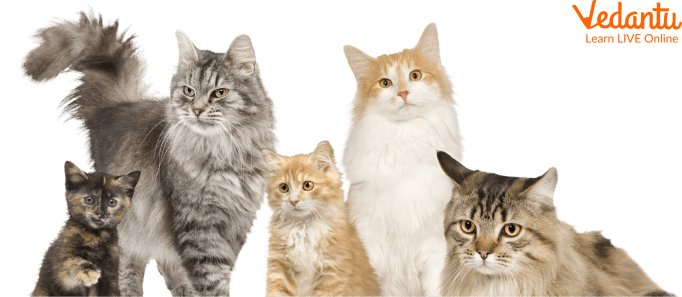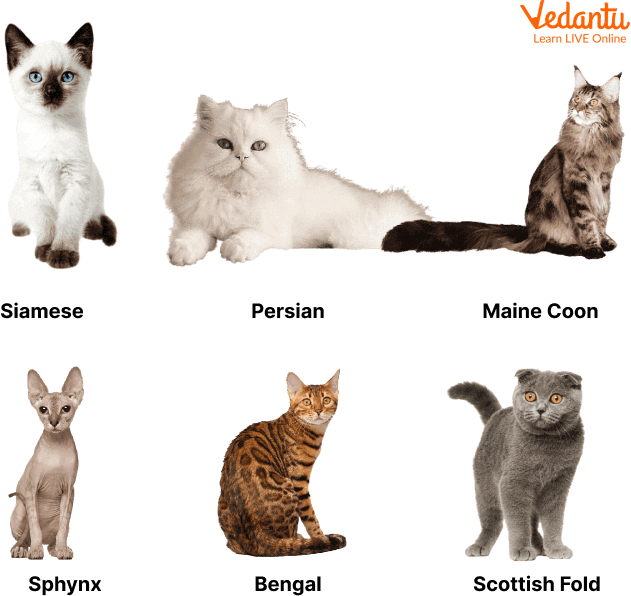




Key Features of a Cat’s Natural Home
Cats are popular household pets that have been domesticated for thousands of years. They are known for their playful and affectionate nature, as well as their ability to hunt small animals like mice and rats. Here, we will explore the fascinating world of these beloved household pets. From their life span and living habitat to the different varieties of cats and some interesting facts, we will cover it all.
Whether you're a cat lover or just curious about these mysterious creatures, this blog is for you. So sit back, relax, and join us as we discover the wonder of cats.

Cats
What are Cats?
Cats are a domesticated mammal species scientifically known as Felis catus. Cats have been kept as pets for thousands of years and are one of the most popular pets in the world today. They come in various colours, patterns, and hair lengths and can be trained to do various tricks and behaviours. Cats are also known for their agility, ability to jump great heights and distances, and always landing on their feet. They have a keen sense of smell and can hear sounds too high-pitched for human ears.
Life Span of Cats
The lifespan of cats varies depending on the breed, but on average, cats live for around 15 years. Some cats can live up to 20 years or more with proper care and nutrition. However, certain breeds, such as the Siamese, have a slightly shorter lifespan of around 12-15 years. Additionally, outdoor cats have a shorter lifespan due to exposure to diseases and injuries, while indoor cats have a longer lifespan.
Regular veterinary check-ups, a healthy diet, and proper exercise can help a cat live a longer and healthier life. It's important to note that cats have a tendency to hide their illnesses, so regular check-ups can help detect and treat any potential health problems early on.
Living Habitat of Cats and Their Benefits
Cats are adaptable animals and can live in various habitats, including homes, apartments, and even outdoors. They are independent animals and do not require as much attention and care as dogs. However, they do need regular veterinary checkups and vaccinations to stay healthy.
Living in a home or apartment is the most common living habitat for cats. It provides them with a safe and controlled environment, protection from extreme weather conditions, and access to food and water. Indoor cats also have a longer lifespan due to less exposure to diseases and injuries. Additionally, indoor cats can be litter-trained, which makes it easier for the owner to take care of them.
Outdoor cats have the freedom to roam and explore, but they are exposed to dangers such as cars, diseases, and other animals. Outdoor cats have a shorter lifespan than indoor cats and are at risk of being stolen or lost.
The benefit of having cats as pets is that they can be low-maintenance and independent. They can entertain themselves with toys and scratching posts and groom themselves. They are also known to be great companions and can provide emotional support to their owners.
Different Varieties of Cats
There are many different varieties of cats, each with its unique characteristics and traits. Some of the most popular breeds include:
Siamese: These cats are known for their distinctive "meow" and are highly active and social. They are also known for their striking blue eyes and pointed coat pattern.
Persian: Persians are known for their long, fluffy coats and round, expressive faces. They are a calm and docile breed, making them a popular choice as companion cats.
Maine Coon: This is the largest domestic cat breed and are known for their friendly, outgoing personality. They have a distinctive "ruff" around their neck, tufted ears, and a long, bushy tail.
Sphynx: Sphynx cats are known for their hairless or almost hairless bodies. They have unique and striking appearances and are known for their affectionate and playful personalities.
Bengal: Bengal cats are a relatively new breed, characterised by their wild, leopard-like appearance. They are highly active and energetic and are known for their intelligence and trainability.
Scottish Fold: Scottish Folds are known for their distinctive folded ears. They are a small to medium-sized breed and are known for their affectionate and playful personalities.

Different Varieties of Cats
Each cat breed has its own unique characteristics and traits, and it's essential to research and understand the characteristics of the breed before deciding to adopt one.
Interesting Facts About Cats
Below are some of the cats fun facts:
Cats have a flexible spine and can rotate their ears 180 degrees. This helps them to locate the source of sounds more accurately.
Cats have a special collar bone (clavicle) that allows them to always land on their feet, a trait known as the "righting reflex."
Cats have a keen sense of smell and can detect certain scents up to a mile away.
Cats have a grooming instinct; they spend 30% of their waking hours grooming themselves.
Cats can run up to 30 miles per hour and jump up to six times their body length.
Cats have retractable claws which they use to climb, balance, defend, and hunt.
Cats have a specialised collar of muscle around their jaws called the temporal muscle, which allows them to bite with great force.
Cats have a third eyelid, known as the "haw," which protects their eyes and keeps them moist.
Summary
Cats are fascinating and beloved animals that make great companions for kids and adults alike. They come in various colours, patterns, and hair lengths and can be trained to do various tricks and behaviours. They have a keen sense of smell and can hear sounds that are too high-pitched for human ears.
Cat’s lifespan varies depending on the breed, but on average, they live for around 15 years. They can live in various habitats, including homes, apartments, and even outdoors, and are independent animals and do not require as much attention and care as dogs.
There are many different varieties of cats, including short-haired and long-haired breeds and different colours and patterns. Cats are unique creatures, and there is still much to learn about them. With proper care and nutrition, cats can live long and healthy lives.
FAQs on Essential Facts About Cats’ Habitat
1. What is the natural habitat of cats?
Wild cats, the ancestors of our pet cats, live in many different places around the world. Their natural habitats include savannahs, forests, scrublands, and even swamps. They are very adaptable and can survive in various environments where they can find food and shelter.
2. What makes a good and safe home for a pet cat?
A good home for a pet cat should be a safe and comfortable environment. It should include:
- A clean, dry, and quiet place to rest, like a soft bed.
- Access to fresh food and water.
- A clean litter box for hygiene.
- Safe toys to play with for mental stimulation.
- Protection from dangers both inside and outside the house.
3. What is the difference between the habitat of a wild cat and a pet cat?
The main difference is that a wild cat's habitat is in nature, while a pet cat's habitat is a human home.
- Wild cats must find their own food, water, and shelter in places like forests or grasslands. They need to protect themselves from predators.
- Pet cats are provided with food, water, and a safe shelter by their owners. Their "habitat" is the house and surroundings they live in.
4. How do cats adapt to their habitat?
Cats have amazing adaptations that help them survive. For example, their sharp claws help them climb trees for safety and hunt for food. Their excellent night vision allows them to be active in the dark. Their soft paws help them move silently to sneak up on prey or avoid danger.
5. What are some common habits of cats that relate to their habitat?
Many cat habits come from their natural instincts for survival in their habitat. They often scratch surfaces to mark their territory and keep their claws sharp. They are very playful, which is practice for hunting. Cats also sleep for many hours a day to conserve energy, just as their wild ancestors did.
6. Why do pet cats love to hide in small spaces like boxes or closets?
This is an instinct from their wild ancestors. In nature, hiding in small, enclosed spaces helped cats feel safe from predators and gave them a secret spot to watch for prey. A box or a closet in a house mimics these safe, den-like shelters, making them feel secure and comfortable.
7. Why is it important for a pet cat to have its own safe space in a house?
It is very important for a cat to have a dedicated safe space because it gives them a place to retreat to when they feel stressed, scared, or just want to be alone. This could be a special cat bed, a cat tree, or a quiet corner. Having this personal territory helps them feel secure and confident in their home environment.
8. What is a cattery?
A cattery is a special place designed specifically for keeping cats. It is not a cat's natural home but a facility where multiple cats are boarded (like a hotel for cats), bred, or cared for. A good cattery provides a clean, safe, and comfortable environment for each cat living there temporarily.





















